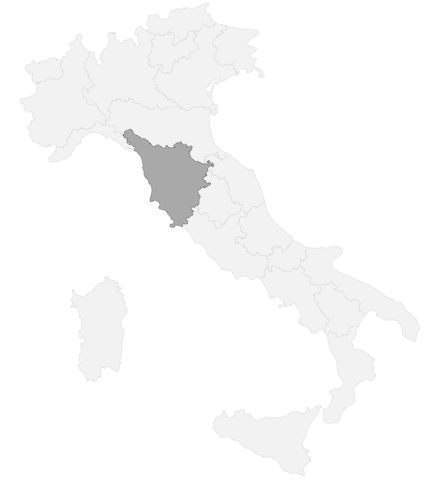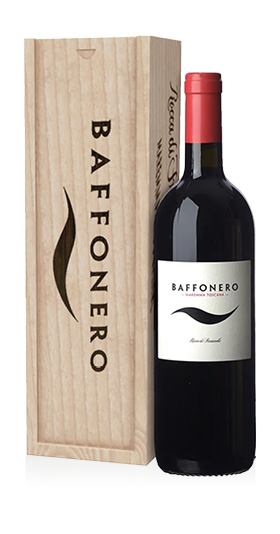Merlot, Tuscany
Originally from the French area of Bordeaux from which the most prestigious wines based on this blend still come today, Merlot is one of the most popular black grape varieties internationally thanks to its great drinkability and high adaptability. Generally the Merlot grapes are processed and vinified with the aim of creating precious blends based on Cabernet Sauvignon where the role of Merlot consists in adding finesse and expressiveness of the fruit by expanding and emphasizing the organoleptic potential of Cabernet Sauvignon. Compared to the origin, Merlot is born in the Bordeaux area from a spontaneous cross between Cabernet Franc and Magdalene Noir de Charentes. If the complementary grape of Cabernet Sauvignon remains in the Medoc region, in the Saint-Emilion area it is the most cultivated and often proposed grape variety, especially in the Pomerol area, a true paradise of this extraordinary grape. Unlike the coastal part where the pebble suitable for the cultivation of Cabernet Sauvignon dominates, in this area the gravelly soils of alluvial matrix are sedimented with sands rich in ferrous minerals and clays, creating a perfect mix for the needs of the vine. The most famous Merlots in the world are born in this AOC, which stand out for the finesse of the aromas of small dark berries, for the extraordinary harmony and complexity, as well as for a refined evolution towards balsamic and mentholated notes. The Pomerol territory was not classified in 1855, but over the centuries a scale of values was created and today the most highly rated labels ever come from: Château Petrus, Château La Fleur, Château L'Eglise Clinet, Château Le Pin, Château La Violette, Château Trotanoy, Château Housanna, Château L'Evangile, Château Clinet, Vieux Château Certan. In addition to this French peculiarity, Merlot remains one of the most widespread varieties in the world, present in almost all European countries, as well as in the countries of the New World. Thus, especially in consideration of its peculiar characteristics, the vinification of Merlot in purity appears increasingly widespread in recent years, offering wines with great personality. In Italy the spread of this grape involves regions such as Friuli Venezia Giulia, South Tyrol, Veneto, Emilia Romagna, Tuscany, Sicily. Precisely in the case of Tuscany, the extreme compatibility of coastal climatic conditions with those present in the Bordeaux area has allowed in recent decades the creation of very successful and qualitatively competitive blends despite the maintenance of recognizable specificities. In addition to being subject to very different harvest times, designed to obtain fresher and less alcoholic or more robust wines in consideration of the ripeness of the fruit, Merlot usually comes in two different versions depending on the climatic conditions affecting the grapes. The most common is the one in which the Merlot grapes are grown in environments where a warm or moderate climate prevails, giving life to a wine with characteristic hints of wild berries mainly black berries such as blueberries, black currants, plums, cherries, often followed also from fresh herbaceous notes of undergrowth; the result is a wine characterized by a soft and velvety body in perfect balance with the body of the tannins and the high alcohol content. The other interpretation is more elegant and slender and is pursued with colder climatic conditions that allow Merlot, thanks to the different maturation, to stand out for greater tannins and acidity. In both cases, Merlot almost always undergoes an aging process in oak barrels, gaining spicy and fragrant notes of vanilla and coffee. Versatile and disruptive wine, Merlot is the red wine loved for its persuasive elegance, soft and rich fruit, smooth profile and balanced, long and persistent sip, without edges or harshness. An enveloping and round wine that over time has conquered the palates of connoisseurs from all over the world. In the Italian case, the appearance of Merlot in response to the damage caused by phylloxera depended on the need to plant new vineyards by selecting better known and more easily marketable varieties. The vine quickly settled in the Triveneto area, in areas that could recall the pebbly and gravelly soils of Bordeaux, such as the alluvial areas of the Greve del Friuli or the Piave area. The vine then spread throughout the peninsula, finding especially in the area of the Tuscan coast, Bolgheri and its hinterland, the pedoclimatic conditions to express itself with high quality levels, exhibiting a decidedly Mediterranean, mature, rich and intense profile. It is grown with excellent results also in Alto Adige, in particular in the Cortaccia area, the sunniest and hottest of the region, in Veneto in the area of the Berici and Breganze hills and in Umbria. I Merlot is history, discovery, adaptation: many are the labels that exalt it at the highest levels such as Masseto Tenuta dell'Ornellaia, Messorio Le Macchiole, Apparita Castello di Ama, Redigaffi Tua Rita, Rennero Gualdo del Re.
Buy Merlot online
If Merlot is a wine appreciated by many amateurs and easily available in wine shops, buying Merlot online is often the best way to reveal its full potential thanks to the immediate comparison of labels and origins. By purchasing Merlot online you can take a journey into the universe of this grape, discovering for example the blends from the coastal areas of Bordeaux and trying stimulating comparisons with Bolgheri wines. Before purchasing, you can devote every attention to discovering its fruity scents and let yourself be surprised by their combination by identifying the delicate herbaceous notes that accompany them. For an even more complete tasting experience, you can decide to buy two pure Merlots online which, if distinguished by harvesting period and winemaking techniques, will allow you to discover if your taste appreciates the freshness and momentum or body of the wine more ripe and expertly refined fruit. In short, buying Merlot online means getting to know wine from the right direction.
What are the characteristics of the Merlot grape?
The main characteristics of the Merlot grape include high vigor and high productivity, both conditions which, when the climatic configurations allow it, make it very adaptable and preferable for new plants.
What is the taste of a Merlot wine?
A wine composed of a high percentage of Merlot or made with pure Merlot has hints of red fruits and ripe plums with interesting herbaceous and spicy hints that manage to complete the organoleptic profile giving a fuller and more structured taste.
Which Italian Merlot is a must try?
There are many Italian Merlots that deserve consideration but some pure Merlot wines such as Masseto have gained worldwide fame to the point of rightfully entering the Olympus of labels to try at least once in a lifetime.

Tuscan wines are, together with those of Piedmont and Veneto, the most famous Italian wines in the world: great excellences such as Brunello di Montalcino, Bolgheri (primarily Sassicaia Bolgheri Doc) and Supertuscan have made known the excellence of made in Italy in the world. In Tuscany, Sangiovese and indigenous grapes are the protagonists alongside international grapes such as Cabernet and Merlot, in a territory that, like no other, seems to have been born on purpose to produce excellent wines. If a legend widespread at the time of the Medici told that Noah with his ark landed in Tuscany and planted the first vine cuttings, what is certain is that in Tuscany the winemaking tradition is so ancient that, unlike other regions, it surpasses the Romans and the Greeks and reaches up to the Etruscan civilization.
Tuscan red wine? A well-stocked cellar cannot be missing.
Tuscan red wines are the red wines for aging par excellence: Brunello di Montalcino has a longevity that exceeds 20 years, and great surprises in this sense also reserve the Nobile di Montepulciano and Carmignano, less known appellations but of ancient tradition, born from the union of Sangiovese with Cabernet Franc brought to Italy by Caterina de 'Medici. However, Tuscan red wine is also synonymous with conviviality, with Chianti in all its nuances, from the traditional flask to the magnum bottles in wooden boxes of the great selections, and above all with Morellino di Scansano, a wild Sangiovese from Maremma. Last but not least other small appellations such as Sant'Antimo Doc, Rosso di Montalcino and Montecucco, in which Sangiovese is and remains the true protagonist. Finally, some producers have tried their hand at Tuscany with the most cursed of the grapes, Pinot Noir, obtaining very interesting results.
Tuscan white wines: a less known reality to be discovered
In Tuscany there is only one Tuscan DOCG white: Vernaccia di San Gimignano. Born from native grapes, it is said that the wine that cuts and pricks was the favorite of the greatest Florentine genius: Michelangelo Buonarroti. Then there are numerous DOC and IGT appellations, which see Vermentino excel, aged in steel or wood, alongside international grapes such as chardonnay and sauvignon. Trebbiano toscano is another widespread grape variety, which combined with malvasia gives life to the famous Vin Santo, in its various and precious golden declinations such as Vin Santo del Chianti Classico and Vin Santo Occhio di Pernice.
What is the finest Tuscan wine?
The most famous Tuscan red, Chianti Classico, links an ancient legend to its main symbol, the black rooster. In fact, it is said that the cities of Siena and Florence had to decide the territorial boundaries by bringing together two knights, both departed to the crowing of the cock, white for the Sienese and black for the Florentines. The Florentines, much more cunning, kept their black rooster stiff, locked in the cage, in the two days preceding the competition and the poor animal, in a panic, opened the cage immediately went out to sing, even if it was the middle of the night. This early departure with respect to dawn allowed Florence to establish the boundary of its province near the city of Siena, where it still is today, in the heart of the Chianti area.
Which is the longest-lived Tuscan DOCG red wine?
The longest-lived Tuscan DOCG red wine is undoubtedly Brunello : it manages to evolve in the cellar even for more than 20 years, developing extraordinary aromas and thus becoming one of the best meditation red wines in the world.
What is the best Tuscan white wine to pair with fish dishes?
The best Tuscan white wine to combine with fish menus is definitely Vermentino which, born from the vineyards caressed by the sea breezes, manages to enhance seafood dishes thanks to its natural flavor and freshness. Seeing is believing!


































